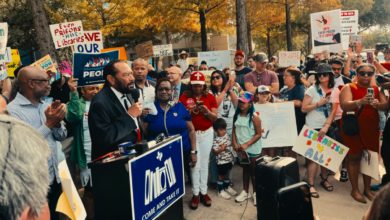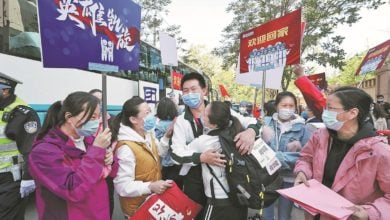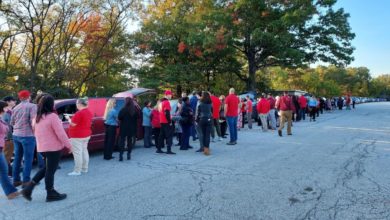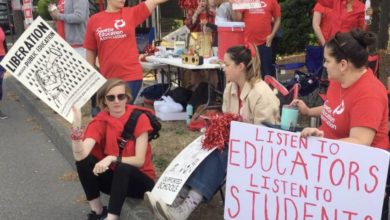Originally posted on RedsInEd.org
As schools across the country begin to reopen this fall, news of teacher deaths due to COVID-19 has heightened concerns for students and school staff safety. Teachers and school staff are faced this year with serious health risks and minimal resources to protect themselves from contracting the virus.
In July, Kim Byrd who was teaching distance learning from the classroom in rural Arizona died of COVID-19. She was sharing a room with two other teachers who also contracted the virus. They had taken many precautions to mitigate the spread of COVID-19.
The same month in rural Leon County Florida, Jordyn Byrd, a Black college student working as a custodian to pay his way through college, died of COVID-19. The school had not reopened to students; administrators were working on sites over the summer. The principal of the school, who is white, also contracted COVID-19 but recovered. In August Jordyn’s mother Jacqueline Byrd, who formerly worked for the same school, also died of COVID-19.
Karen Bradwell, the mother of Jordyn’s girlfriend, died of the virus as well. Bradwell was an after school program coordinator. The Byrd family tragedy highlights the disparity in COVID-19 deaths in the United States, where novel coronavirus fatalities of Black people is three times that of whites.
This fall, COVID-19’s toll on educators has continued. Since early August, six teachers in at least five different states have died after contracting COVID-19; the majority of these deaths claimed the lives of teachers under the age of 50 in states such as Oklahoma, South Carolina, Missouri, Mississippi and Iowa.
Communities lose beloved teachers
Demetria “Demi” Bannister, a 28-year-old third-grade teacher in South Carolina, had spent no more than two weeks in her classroom before she had been diagnosed with the virus. Bannister was diagnosed with COVID-19 on a Friday and died three days later, according to a school district spokesperson.
In spite of Bannister’s alarming death in August, school districts continued to ignite public health concerns and reopen across the nation. 34-year-old AshLee DeMarinis, a special education teacher in Missouri, died on September 6 due to complications from the virus. DeMarinis, who had asthma, spent three weeks in the hospital on a ventilator before ultimately losing her battle with the virus. Thomas Slade, a high school teacher in Vancleave, Miss. also died on September 6 from complications due to COVID-19.
In Mississippi, a 42-year-old teacher and assistant football coach, Nacoma James, died in early August after continuing to coach football throughout the summer. At the time of James’ death, Mississippi had the highest number of COVID-19 cases, yet Governor Tate Reeves opted to reopen schools against the advice of top medical experts. Reeves’s decision to reopen schools, decried by the Mississippi Association of Educators as “reckless and irresponsible,” places education workers in an impossible position that will undoubtedly claim more lives as the COVID-19 pandemic continues to ravage the country.
On August 30, 62-year-old Theresa Horn, a special education teacher at Tahlequah Public Schools in Oklahoma, died after contracting COVID-19. Tahlequah Public Schools responded by announcing two days of virtual learning, followed by a return to in-person instruction shortly thereafter. Since Horn’s death, Tahlequah Public Schools has announced near-daily reports of new COVID-19 diagnoses and community exposure among students and teachers.
In Iowa, a longtime special education teacher died after contracting COVID-19 in early September. The teacher, whose name was not released to the media, represents the first known COVID-related death of an Iowan educator. In Iowa, school districts must follow a statewide mandate to conduct 50 percent of classes in person.
All six of these teachers have been memorialized in outpourings of support and grief from students and educational workers alike. The loss of a teacher in any community constitutes a traumatizing experience; the death of a beloved teacher forced to work in unsafe conditions compounds the tragedy.
Political motivations unmasked
While school reopening is often framed in terms of “student needs,” it is clear that student needs regarding safe and consistent education continue to be unmet and ignored. There is no doubt that for most students in-person education is much more preferable to remote learning, which exacerbates systemic inequities with regard to technology access and housing crises. However, the deaths of these six teachers–and the haunting reality that the death toll will not stop at six–represent a public health emergency which must be immediately addressed by state and federal governments.
Reopening schools is by and large not a response to the needs of young people in the United States. The historic neglect of public schools is evidence enough that education is not the motivator for this political decision. Public schools in U.S. working-class communities are criminally under-resourced, often lacking basic necessities such as soap in student bathrooms or clean drinking water. Teachers and staff who work in these institutions are underpaid and overburdened, serving far more students than their suburban counterparts. These conditions were disturbing well before the COVID-19 pandemic emerged, and reopening schools in communities ravaged by the virus creates a scenario in which community spread is inevitable.
The true motivation for reopening schools is an attempt to force working-class people back into the workplace. It is an attempt to ameliorate the disastrous failure of the U.S. government to adequately address the crisis through public health and economic relief measures. The United States government, which has eroded social safety nets throughout the previous four decades, is unwilling and structurally unable to provide for families in need throughout the duration of the pandemic.
Unions fight back
Strong unions are the last line of defense for education workers. It is important to note that four of the five states where teachers have died from COVID-19 in 2020 are so-called “right to work” states which restrict the ability of workers to form unions and engage in collective bargaining. Unions with political power, on the other hand, are better able to advocate for educational workers’ and students’ needs.
In Syracuse, NY, teachers successfully lobbied for a delayed reopening; Syracuse City Schools are now conducting remote learning until a review of the situation in October. Until the Syracuse Teachers Association began to organize in response to teacher and student health, SCSD planned to reopen in September along with other suburban districts in the region.
“Remote education is not perfect, but it is a reasonable choice to help bridge the gap in districts where educators and parents are not yet confident that reopening buildings is safe to do,” remarked NYS United Teachers President Andy Pallotta.
State and federal governments in the United States have demonstrated a consistent, criminal negligence towards public schools. In light of this situation, unions are a crucial tool for the working class to protect the health and safety of children, families and the community.






